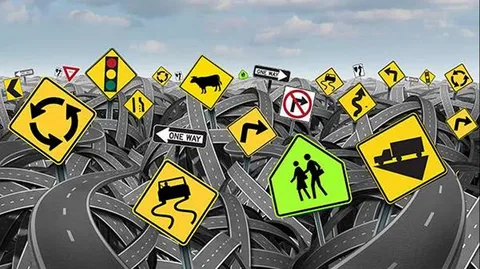
Qatar, a rapidly developing country in the Middle East, boasts a modern and extensive road network. As the nation continues to grow and attract international visitors, understanding Qatar’s road signs becomes crucial for both residents and tourists. This comprehensive guide will explore the various types of road signs in Qatar, their meanings, and importance in ensuring road safety.
Types of Road Signs in Qatar
Qatar follows an international standard for road signs, making them easily recognizable for most drivers. The main categories of road signs include:
- Regulatory Signs
Regulatory signs in Qatar are designed to inform drivers of traffic laws and regulations. These signs are typically circular or triangular and use red, blue, and white colours. Some common regulatory signs include:
- Speed limit signs
- Stop signs
- No entry signs
- No parking signs
- Mandatory direction signs
- Warning Signs
Warning signs alert drivers to potential hazards or changes in road conditions. These signs are usually triangular with a red border and a white or yellow background. Examples include:
- Curve ahead
- Pedestrian crossing
- School zone
- Roundabout ahead
- Road works
- Information Signs
Information signs provide drivers with useful details about their surroundings, directions, and facilities. These signs are typically rectangular with a blue background and white text or symbols. Some common information signs in Qatar include:
- Direction signs to cities and landmarks
- Hospital and emergency services
- Parking areas
- Rest stops and fuel stations
- Tourist attractions
- Lane Control Signs
Lane control signs guide drivers on proper lane usage and indicate which lanes are open or closed. These signs are often overhead and use green arrows or red X symbols to convey information.
Unique Aspects of Qatar’s Road Signs
While Qatar generally follows international standards, there are some unique aspects to its road signage system:
- Bilingual Signs Most road signs in Qatar feature both Arabic and English text, making them easily understandable for both local and international drivers.
- Desert-Specific Signs Given Qatar’s desert environment, there are specific signs warning drivers about potential hazards such as sand drifts, camels crossing, and strong winds.
- Smart Signs Qatar has begun implementing smart road signs that can display real-time information about traffic conditions, weather alerts, and other important updates.
Importance of Understanding Road Signs in Qatar
Comprehending Qatar’s road signs is crucial for several reasons:
- Safety: Proper understanding of road signs helps drivers anticipate potential hazards, follow traffic rules, and make informed decisions while driving.
- Efficiency : Knowing how to interpret directional and informational signs allows drivers to navigate Qatar’s roads more efficiently, saving time and reducing frustration.
- Legal Compliance Failure to obey road signs can result in fines and other penalties. Understanding and following these signs helps drivers avoid legal issues.
- Cultural Respect By adhering to local road signs and regulations, visitors demonstrate respect for Qatar’s laws and culture.
Tips for Understanding Qatar’s Road Signs
- Familiarise yourself with common signs before driving in Qatar.
- Pay attention to colour codes and shapes, as they often indicate the type of sign.
- When in doubt, err on the side of caution and follow the most restrictive interpretation of a sign.
- Use GPS navigation as a supplement to road signs, not a replacement.
- Be aware of digital signs that may display changing information.
Conclusion
Understanding Qatar’s road signs is essential for safe and efficient travel within the country. By familiarising yourself with the various types of signs, their meanings, and unique aspects of Qatar’s signage system, you can navigate the roads with confidence. Remember that road signs are designed to protect all road users and maintain order in traffic. As Qatar continues to develop and attract more international visitors, the importance of clear and effective road signage will only increase.
FAQs
Q1: Are Qatar’s road signs different from international standards?
A: While Qatar generally follows international standards, there are some unique aspects such as bilingual signs and desert-specific warnings.
Q2: Do I need to understand Arabic to read Qatar’s road signs?
A: No, most road signs in Qatar feature both Arabic and English text, making them accessible to international drivers.
Q3: What should I do if I encounter a road sign I don’t understand?
A: If you’re unsure about a sign’s meaning, it’s best to proceed with caution and follow the most conservative interpretation. When safe to do so, you can look up the sign’s meaning or ask a local for clarification.
Q4: Are there any specific signs I should be particularly aware of when driving in Qatar?
A: Pay special attention to signs warning about desert-specific hazards such as sand drifts, camels crossing, and strong winds.
Q5: How are speed limits indicated in Qatar?
A: Speed limits are typically shown on circular signs with a red border and the speed limit number in the center.
Q6: What are the consequences of ignoring road signs in Qatar?
A: Ignoring road signs can result in fines, traffic points on your license, and in severe cases, legal prosecution. It’s always best to obey all road signs for your safety and legal compliance.